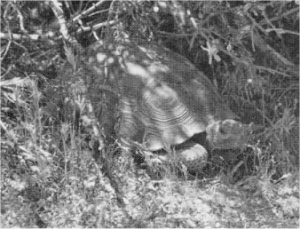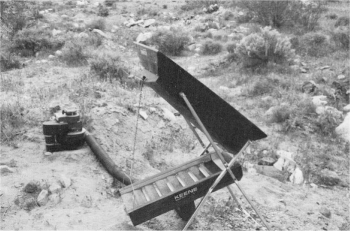By George Mullen
 Most traditional methods for recovering gold from gravels require an ample supply of water. However, an old prospector’s adage has it that gold is where you find it. In the southwest, the “where” is all too frequently situated miles from even a trickle of water. Dry-washing of gold-bearing soil or gravel provides an effective solution to this dilemma.
Most traditional methods for recovering gold from gravels require an ample supply of water. However, an old prospector’s adage has it that gold is where you find it. In the southwest, the “where” is all too frequently situated miles from even a trickle of water. Dry-washing of gold-bearing soil or gravel provides an effective solution to this dilemma.
Click here for a more thorough explanation of dry-washing techniques.
The Spaniards used a scheme similar to the winnowing of wheat from chaff and straw. Two men would grab the comers of a blanket, upon which a small quantity of classified gold-bearing material had been placed, and they repeatedly would toss it upward into the air. The wind would blow away the lighter fraction, and any gold and black sands, which are heavier, would fall back onto the blanket. Wool blankets worked best, because the static electrical charge generated by the wool tended to attract fine-sized gold on the blanket’s surface.
The modem prospector uses an efficient tool called a dry-washer to extract the ever-elusive gold particles from screened gravels or other material. Dry-washers can range in size and complexity from hand-shovel-fed models, to large machines serviced by wheeled or tracked front-end loaders.
All dry-washing machines require a low-pressure, high-volume source of air. At the low-cost end, this can be provided by a bellows which is linked to a hand-operated crank or motor-driven fly wheel. At the higher-cost end, the air source is typically provided by a gasoline engine-driven blower. The remaining components of a dry-washer combine to construct a sloped classification screen (or “grizzly”), which routes fine-sized material to a pneumatic sluice box, where a mechanically-modulated flow of air accomplishes the separation of gold from the lighter-weight material which contains no value.
 A dry-washer for small-scale prospecting might consist of a rectangular screen with 1/2 inch openings over a sloped trough. The screened material would pass from the lower-end of the trough to the head-end of a sloped riffle tray consisting of cotton fabric stretched over an inner frame. The tray includes sides to contain the flowing material, and its surface is interrupted by five crosswise riffles. Under the tray is a hollow box and the mechanism which modulates air flow through the tray at a rate of about 200 puffs per minute. The rate of air flow is designed to be sufficient to lift lighter material over the riffles, while the gold remains trapped. When everything is working right, the flow of material through the riffle tray resembles water flowing through a conventional sluice box.
A dry-washer for small-scale prospecting might consist of a rectangular screen with 1/2 inch openings over a sloped trough. The screened material would pass from the lower-end of the trough to the head-end of a sloped riffle tray consisting of cotton fabric stretched over an inner frame. The tray includes sides to contain the flowing material, and its surface is interrupted by five crosswise riffles. Under the tray is a hollow box and the mechanism which modulates air flow through the tray at a rate of about 200 puffs per minute. The rate of air flow is designed to be sufficient to lift lighter material over the riffles, while the gold remains trapped. When everything is working right, the flow of material through the riffle tray resembles water flowing through a conventional sluice box.
My dry-washer was built from a plan published by Carl Fischer. It is mostly constructed of wood and is extremely portable. A small gasoline engine drives the air box via a belt and pulley speed reducer, producing the required 200 puffs of air per minute. The end result is an efficient separator which saves even the finest particles of gold. I have checked the tailings on numerous occasions and have yet to find any significant amount gold in them.
Prospecting for gold in the desert uses techniques similar to those that are used to locate placer gold on flowing streams or within old stream channels. You want to sample dry-washes on pediments to mountains, feeder-canyons in the mountains and ancient streambeds.
Another old prospector’s adage suggests that one should look for gold where it has been found before. This is still sound advice!
Very fine gold is abundant at many sites in the northwest, and the usual methods of final gold recovery do not always work very well. I have found that the screening and drying of dredge or high-banker concentrates, and then running them through my dry-washer, really works well. I use a metal detector to monitor both the feed and the tailings.
After processing pay-dirt material for about an hour, I suggest it is usually a good idea to clean-up the riffles to check your recovery. I use a plastic gold pan and small wash tub for the final clean-up and have operated all day on just a few gallons of water.
My wife, some friends and I operate suction dredges and high-bankers on the extensive New 49’er properties near Happy Camp, California during the summer months, where there is always an abundance of water. Our dry-washer allows us to remain active during the winter, usually around Quartzsite, Arizona. These gold prospecting and mining activities provide enjoyable activity, along with an extra source of income when we need it.





